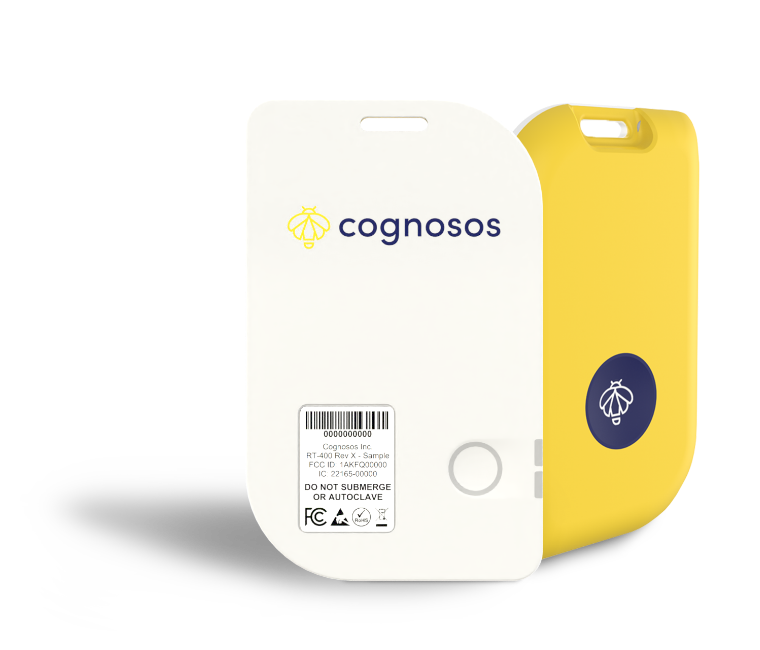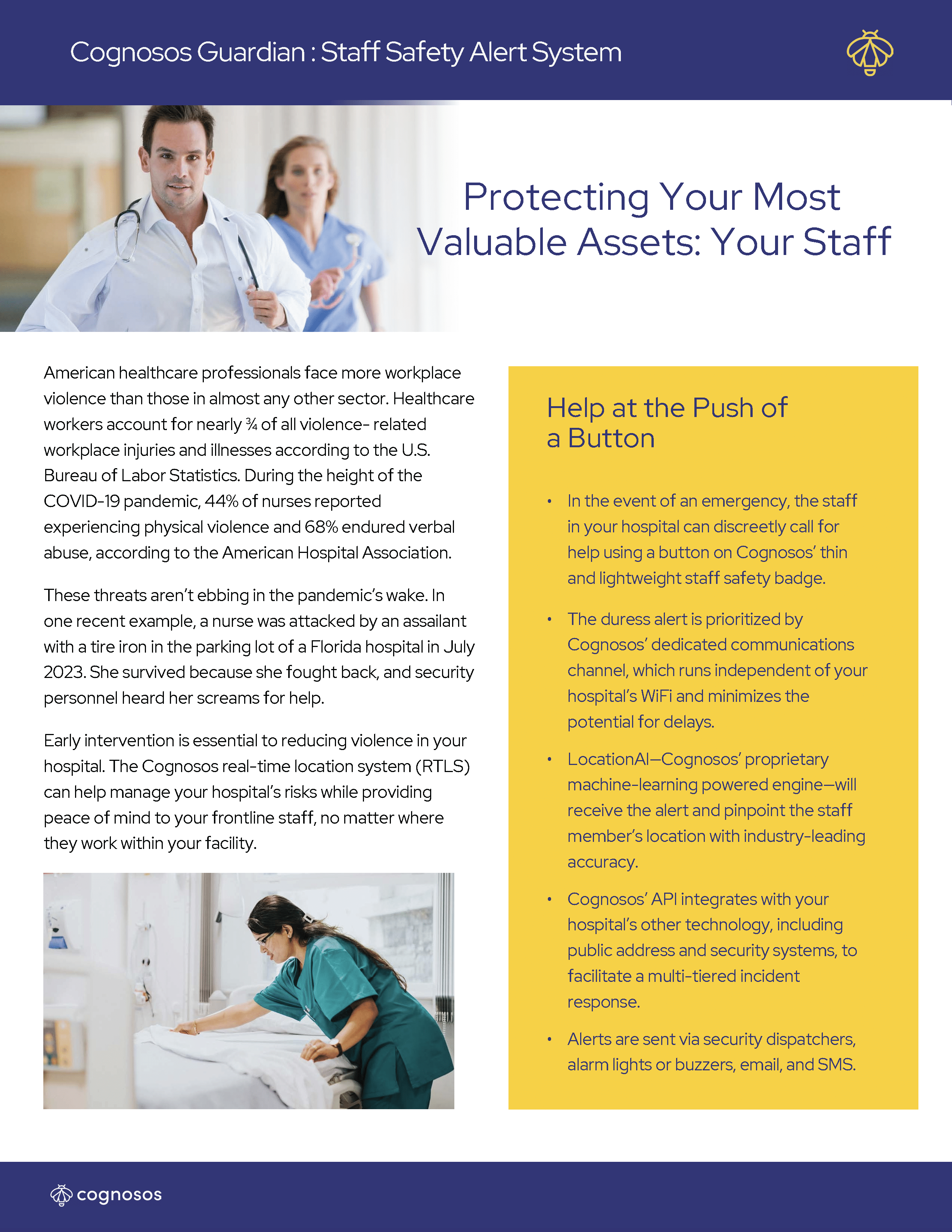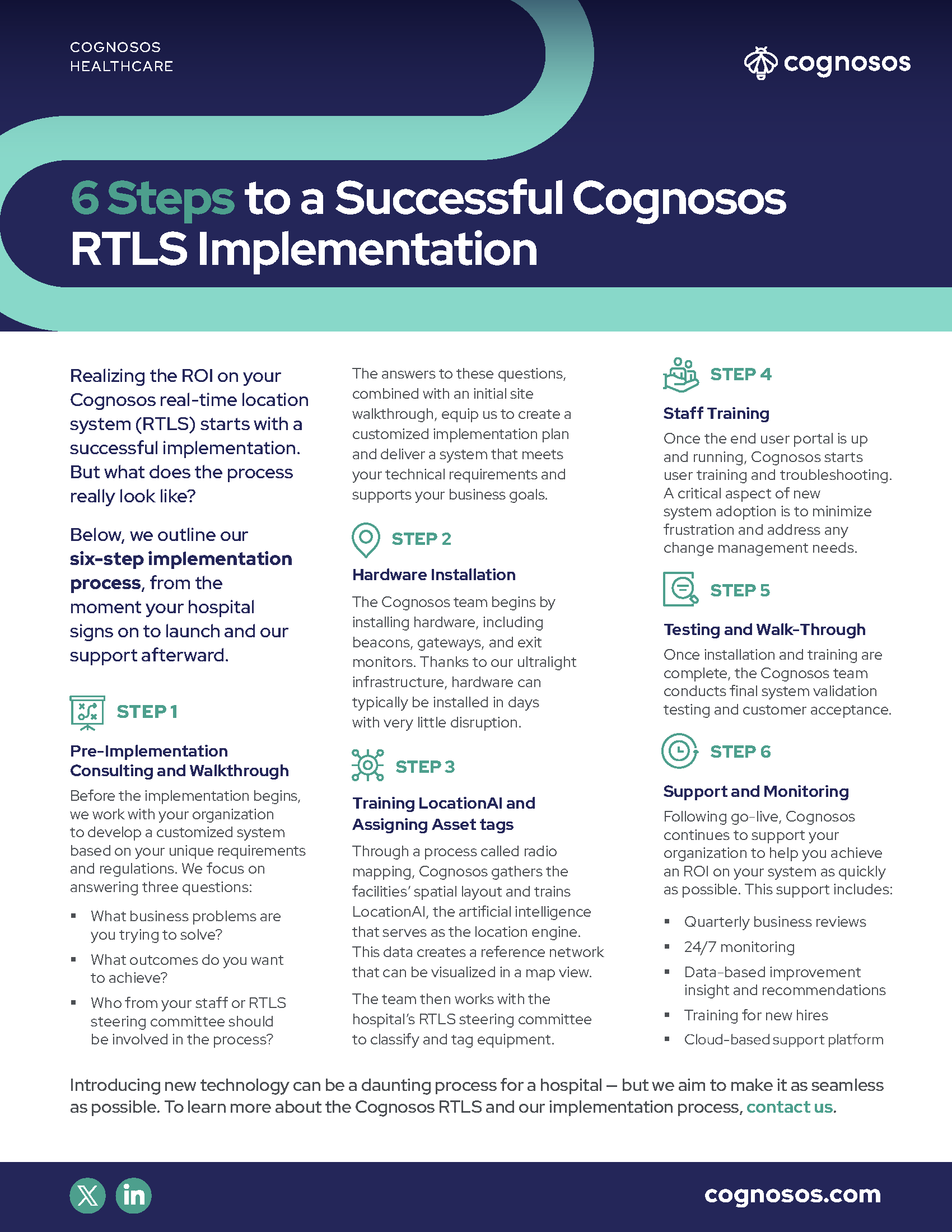Safety
Cover Everyone Everywhere with Campus-Wide Staff Safety & Duress
From the time they park until the time they leave – staff throughout the hospital remain covered by Cognosos Safety.
- Enable rapid, location-aware incident response
- Build staff confidence and meet new safety mandates
- Ensure accurate duress coverage, inside and outside

It’s more important than ever to protect your staff
80%
Of hospital staff said they would feel safer with a badge to protect them at work
40%
Of healthcare employees were victimized in the last two years
76%
Of all nurses experience verbal and/or physical violence on the job
26%
Of healthcare workers considered leaving their job because of workplace violence

How we’re different
Your staff deserve the best protection
Not all duress solutions are built equally, and your staff deserves the best protection on the market. Discover why hospitals are choosing Cognosos as their staff safety partner.

Accurate location from start to finish
Know exactly where the duress event is occurring and remain updated as the event progresses.

Complete campus-wide protection
From pathways to parking and everywhere in the hospital, your staff is protected.

Dedicated low latency network
Duress events utilize a dedicated high priority channel to immediately send notifications enabling a rapid response.

Rapidly available duress protection
Low-cost, easy to deploy duress solution with full incident response stack.
Prioritize safety
Create a safer, more attractive work environment
Stay ahead of other hospitals by implementing a duress solution to show employees and potential employees that staff safety is a top priority for your facility. Cognosos’ streamlined infrastructure simplifies the deployment of a comprehensive duress solution for hospitals which offers your staff rapid access to a duress solution from start to finish and assists your safety and management teams in developing a workplace violence plan to comply with regulatory and legislative guidelines and mandates.
80%
of hospital and clinical staff would feel safer with a duress solution at their hospital
- Improve staff retention and hiring efforts with a proactive safety strategy
- Fastest solution delivery from contract to safety
- Avoid lengthy IT projects with lightweight infrastructure


Mobile duress
Find staff right away & throughout the event
60%
Nurses left, changed jobs, and consider leaving due to WPV
NNU
Responding promptly to duress events hinges entirely on the precision of location updates. You wouldn’t want to respond to the parking garage when the event has already shifted to a walkway. Cognosos Guardian’s wearable alerting solution enables you to implement a successful safety by design program.
Rest assured, your staff is safeguarded with a duress solution that instantly triggers alerts on a low-latency and dedicated alerting infrastructure and delivers precise, ongoing location updates.
Campus-wide coverage indoors & outdoors
One of the only RTLS platforms to provide safety both inside and outside, offering complete campus-wide coverage.
Stay on top of unfolding incidents
Receive continuous location updates as the event unfolds to ensuring help is arriving where the staff member is, not where they were.
Avoid Wi-Fi communication delays that impact response time
Dedicated communication infrastructure with low latency designed to trigger alerts immediately.
Staff worn badge
Purpose built based on decades of healthcare experience
81%
NNU
Unlike the duress button which is typically located on the wall behind the patient bed, we designed our solution to provide support where the user needs it, right at hand. We leveraged over 20 years of experience inside hospitals to ensure we keep hospital staff safe in real-life working conditions.
Everything from the badge, button placements, and end-user workflow is designed specifically for hospital staff, keeping them protected all day, every day.


Discreet button placement to avoid escalation
Your staff can easily find and press the duress button without taking their eyes off of the potential threat. A silent buzz is felt when the button is pressed to confirm that an alert was sent, and help is on the way.
Minimize infection risk
Specifically designed with smooth surfaces and minimal seams to avoid collecting contaminants.
Self-test feature
Maintain your staff’s peace of mind with an easy to use built-in self test feature that can be completed before they start their shift.
Our process explained
Keeping your staff protected
Discover how hospitals ensure staff safety by effectively responding to incidents and improving over time.

STEP 01
Staff press duress button
Specifically designed for staff to easily press the duress button while being discreet enough to avoid escalation.

STEP 02
Alert responders and staff quickly
Alert staff closest to the event using a dedicated low-latency network to ensure the quickest response.

STEP 03
Continuous location updates & alerts
Stay on top of an unfolding incident with real-time tracking 6 hours after the button is pressed or until alerts are cleared.

STEP 04
Automatic log into incident management system
Maintain compliance with regulatory guidelines and standards while improving your processes and responses with forensic reporting.
Safety resources

Safety overview

How AI changed the RTLS game white paper

6 Steps to a successful Cognosos RTLS implementation

Transforming hospitals for future success in 2030 & beyond

Cognosos Safety
Hospital staff safety & duress
Protect everyone, everywhere with campus-wide staff safety & duress solution.
Request a demo
Everything you need to know about
Healthcare duress & staff safety
What is a staff duress & safety solution?
A duress and safety solution is often a key part of workplace violence prevention programs. A staff duress system ensures the safety of healthcare workers in potentially dangerous situations. Discreet yet effective, the system allows staff to quickly alert security personnel during an emergency situation, often pinpointing their location.
What is a hospital panic button?
A hospital panic button is a wearable or stationary emergency device that allows healthcare staff to instantly summon help during threatening situations, medical emergencies, or workplace violence incidents. These devices send silent alerts to security personnel, providing the staff member’s exact location for immediate response.
Why is a comprehensive program to address workplace violence so important?
According to the Bureau of Labor Statistics, healthcare workers are nearly five times more likely to be assaulted due to workplace violence than all other workers in the private sector combined. And the numbers are rising: A reported 40 percent of healthcare workers experienced an incident of workplace violence in the last two years. In addition, hospitals must now comply with Joint Commission and OSHA regulatory requirements/guidelines and state-by-state legislation designed to mandate the development of workplace violence programs for staff safety in hospitals.
Why have attacks on nurses and other healthcare staff become more frequent?
There are a variety of reasons that an ever-increasing number of healthcare workers have become the target of workplace violence:
- Increasing use of hospitals by the criminal justice system for criminal holds and the care of acutely disturbed, violent individuals
- Increasing number of acute and chronic mentally ill patients for whom adequate inpatient and follow-up care is not available
- Long waits for service and overcrowded waiting rooms
- Availability of medication, particularly opioids, amidst a national opioid crisis
- Increasing presence of substance abusers
- Distraught family members
- Isolated work with patients during examinations or treatment
- A workforce that is predominantly female
- Poorly lit corridors, rooms, parking lots, and other areas
- Lack of staff training and policies for preventing and managing crises with potentially volatile patients
- Understaffing
What staff duress & safety solutions have been employed in hospitals and why did they fail?
There has been an assumption that de-escalation training alone is enough to protect clinical teams from violence, but the data shows that violence has only increased despite training.
For many years, the only alerts available when a situation escalated were hard-wired duress buttons installed on walls for convenient electrical access. They are often placed in areas where the clinical staff can’t access them in an emergency, sometimes in a hallway or at the nurse’s station, which is often too far from the event. Another common spot for a duress button is behind the patient’s head on the wall, which is not accessible when a patient becomes your assailant
What should be included in a solution for WPV?
A comprehensive workplace violence prevention program is the best way to reduce violence in the workplace. A successful program should include these foundational elements:
Management commitment and employee participation
In order for a WPV to succeed, management must demonstrate their commitment to the program, communicate that commitment, and document its performance. Workplace violence prevention should be a priority, goals and objectives should be established, and communication between management and employees should be open and without fear of reprisal.
Worksite assessment/analysis
An initial identification of any hazards should take place, with continual reassessments and formal re-evaluations after incidents, through accident review boards or after-action reviews.
Hazard prevention and control
Once hazards are identified, controls should be put in place to reduce or eliminate them. These could include alarm and/or staff duress systems, training and posting of security, and adequate staffing.
Safety and health training
All employees should have education and/or training on hazard recognition and control, including what to do in an emergency.
Recordkeeping and evaluation
Hospitals should establish a process for continually monitoring, internally reporting, and investigating all instances of violence and any safety and security incidents involving patients, staff, or others.
What are the components of the Cognosos RTLS staff duress and safety solution?
Badges designed to be discreet (similar to a typical hospital asset badge) and inconspicuous to an assailant
Alerts sent with the push of a button on the badge
A dedicated communication channel that relays the emergency alert quickly
Integration with hospital emergency codes (Code Gray) to ensure all staff are aware that an incident is in progress
Continuous location of the person who is at risk while the event is ongoing
Reporting about the incident response in compliance with the hospital’s workplace violence prevention plan
How critical is location for a staff duress and safety solution?
Having an RTLS that offers room-level accuracy with high confidence is essential when an incident involves more than one location. If an assailant is moving around the hospital—especially if they have a staff member or patient in tow—first responders need to go to their current location, not where they were five minutes ago when a staff duress button was pushed.
What areas should a staff duress and safety solution cover?
- The entire hospital footprint, including patient rooms, offices, closets and storage rooms, restrooms, hallways, and loading docks
- Pathways leading to and around the hospital
- Parking lots and garages
How does the Cognosos staff duress and safety solution work?
- A staff member personally experiences or witnesses an incident of workplace violence.
- The staff member presses a button on their wearable badge to alert the hospital that an incident is in progress.
- A designated department of the hospital receives the alert and initiates an emergency response; a Code Gray emergency code is announced throughout the hospital.
- After the incident is over, Cognosos collects data about the hospital’s response for use in a report according to the workplace violence prevention plan.
How does a staff member activate the duress button?
- Buttons are located on a badge or similar device worn by hospital staff.
- When a staff member witnesses or experiences an incident of workplace violence, they press the button on the badge.
- After the button is pressed, the badge sends a message to the designated hospital department responsible for responding to the incident.
What happens after a staff member activates the duress button?
- The badge will provide a silent, tactile “buzz” when the duress button is pushed, assuring the staff member that help is on the way without alerting or agitating an assailant.
- The badge sends a message through a low-latency communication channel separate from the hospital’s network that prioritizes emergency calls.
- An emergency code announcement (Code Gray) is made over the public address system, informing staff that an incident is in progress.
- During and after the incident, Cognosos collects data from and publishes the information via a dashboard. That information is included in reports the hospital must produce to meet standards (from The Joint Commission, OSHA, and other regulatory and legislative entities) for workplace violence prevention plans.
What are the benefits of a staff duress system?
Meeting The Joint Commission, OSHA, and other regulators’ workplace violence prevention plan requirements
- The Joint Commission’s 2022 guidance requires hospitals to establish processes for monitoring, reporting, and investigating all safety and security incidents; deliver ongoing safety and security education and training; and conduct an annual analysis of their workplace violence prevention plan.
- OSHA guidance requires all hospitals and healthcare facilities have a system-wide workplace violence prevention plan that includes duress buttons, workstation paging systems, or personal alarm devices worn by staff.
A proactive approach to prevention
Although no technology or system can prevent all incidents of workplace violence, a staff duress and safety solution ensures your hospital has resources to help keep incidents from escalating if and when they occur.
Improved performance by staff
The Joint Commission has noted that exposure to workplace violence can lead to psychological distress and stress, which can negatively impact patient care because staff are not 100% focused on their responsibilities.
Increased job satisfaction
Reliable staff duress and safety solutions can facilitate a culture of safety in your hospital, giving your staff peace of mind. They know that if they or their patients are in danger, they can immediately report the incident and there will be a swift emergency response. Their peace of mind extends to the parking lots or garages and pathways they use to arrive at and depart from work.
Improved recruitment of staff/reduced turnover
Healthcare staff want to work at a hospital where they know they’ll be able to do their jobs as safely as possible. The presence of an easy-to-use and effective staff duress and safety solution may be a factor that prospective employees consider when choosing a hospital to work for. The lack of such a solution may be a deciding factor for those considering whether to stay in their current jobs.
What systems does a staff duress and safety solution integrate with?
A staff duress and safety solution should have an API that communicates with other systems, such as the hospital’s public address system (e.g., for emergency announcements) and security systems (e.g., to lock down specific areas to isolate an emergency and alert security staff) to facilitate a multi-tiered incident response.
What is required to comply with agencies that have current and upcoming regulations and guidelines for hospitals?
The Joint Commission created new and revised workplace violence prevention stardards that became effective on January 1, 2022 for all Commission-accredited hospitals and critical access hospitals.
The Hospital Manages Safety & Security Risks (EC.02.01.01)
The hospital conducts an annual worksite analysis related to its workplace violence prevention program. It takes actions to mitigate or resolve the workplace violence safety and security risks based upon findings from the analysis. A worksite analysis includes a proactive analysis of the worksite, an investigation of the hospital’s workplace violence incidents, and an analysis of how the program’s policies and procedures, training, education, and environmental design reflect best practices and conform to applicable laws and regulations.
The Hospital Collects Information to Monitor Conditions in the Environment (EC.04.01.01)
The hospital establishes a process(es) for continually monitoring, internally reporting, and investigating the following:
- Injuries to patients or others within the hospital’s facilities
- Occupational illnesses and staff injuries
- Incidents of damage to its property or the property of others
- Safety and security incidents involving patients, staff, or others within its facilities, including those related to workplace violence
- Hazardous materials and waste spills and exposures
- Fire safety management problems, deficiencies, and failures
- Medical or laboratory equipment management problems, failures, and use errors
- Utility systems management problems, failures, or use errors
- Based on its process(es), the hospital reports and investigates the following: Safety and security incidents involving patients, staff, or others within its facilities, including those related to workplace violence.
Staff participate in ongoing education and training (HR.01.05.03)
As part of its workplace violence prevention program, the hospital provides training, education, and resources (at time of hire, annually, and whenever changes occur regarding the workplace violence prevention program) to leadership, staff, and licensed practitioners. The hospital determines what aspects of training are appropriate for individuals based on their roles and responsibilities. The training, education, and resources address prevention, recognition, response, and reporting of workplace violence as follows:
- What constitutes workplace violence
- Education on the roles and responsibilities of leadership, clinical staff, security personnel, and external law enforcement
- Training in de-escalation, nonphysical intervention skills, physical intervention techniques, and response to emergency incidents
- The reporting process for workplace violence incidents
Leaders Create & Maintain a Culture of Safety & Quality Throughout the Hospital (LD.03.01.01)
The hospital has a workplace violence prevention program led by a designated individual and developed by a multidisciplinary team that includes the following:
- Policies and procedures to prevent and respond to workplace violence
- A process to report incidents in order to analyze incidents and trends
- A process for follow up and support to victims and witnesses affected by workplace violence, including trauma and psychological counseling, if necessary
- Reporting of workplace violence incidents to the governing body
OSHA Guidelines
OSHA has guidelines that healthcare facilities and hospitals can follow to create system-wide WVP program that includes:
- Panic buttons, workstation paging systems, or personal alarm devices worn by staff
- Creation and maintenance of a workplace violence prevention plan
- Employee consultation on and involvement in the workplace violence prevention plan
- Safe worksite analysis
- Hazard prevention and control
- Recordkeeping
- Program evaluation
State and federal guidelines and legislation
Several states including California, Connecticut, Illinois, Maryland, MInnesota, New Jersey, Oregon, and Washington have passed laws requiring workplace violence prevention programs for healthcare facilities and hospitals, and many others have legislation in progress.
What happens to facilities that do not have a WPV plan in place?
If a hospital fails to create a workplace violence program, there can be significant penalties involved. The Joint Commission may revoke a hospital’s accreditation, while OSHA has issued fines under its General Duty Clause, which requires employers to provide employees with a place of employment that is “free from recognized hazards that …are likely to cause death or serious physical harm.” The organization has fined several hospitals for failing to protect their employees against workplace violence, including one Pennsylvania hospital that was fined more than $32,000. Additionally, some states have laws that establish penalties for assaults on healthcare workers.
How long does it take to install a staff duress and safety solution?
Implementation time depends on several factors, such as facility size and involvement of hospital IT staff. Because the Cognosos staff duress and safety solution runs on such light infrastructure, however, the time from contract to use is among the shortest on the market.
